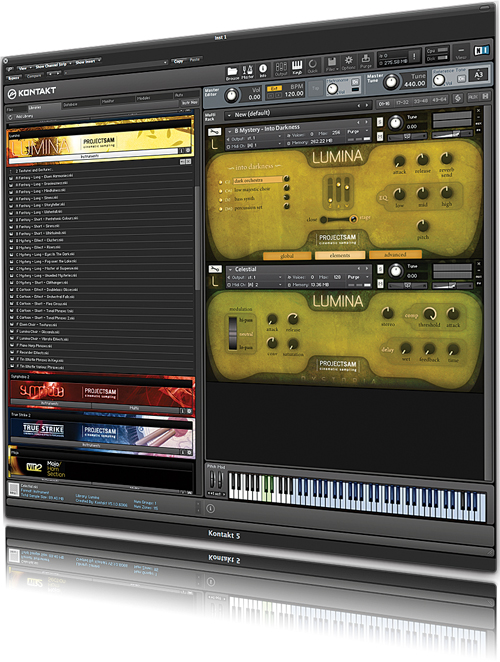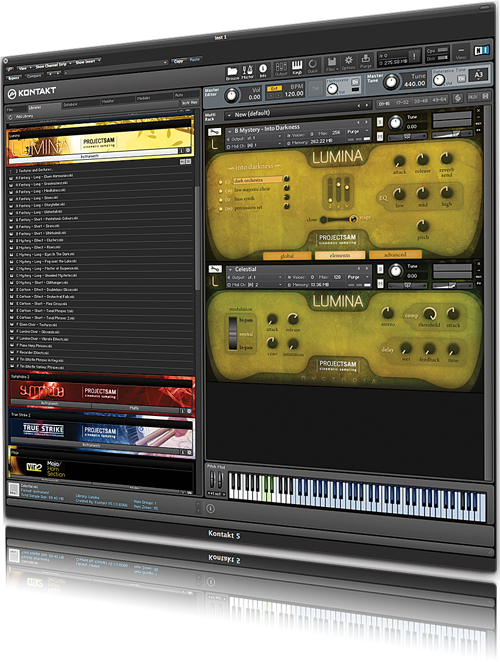Project SAM Lumina Review
The third of Project’s SAM popular Symphobia series takes a musical journey into fantasy and mystery. Mark Cousins reports in this review of Project SAM’s Lumina Amazon.co.uk Widgets Along with Vienna Symphonic Library, Project SAM can rightly claim to being one of the pioneering developers of cinematic sampling, long before the veritable gold rush of […]

The third of Project’s SAM popular Symphobia series takes a musical journey into fantasy and mystery. Mark Cousins reports in this review of Project SAM’s Lumina

Along with Vienna Symphonic Library, Project SAM can rightly claim to being one of the pioneering developers of cinematic sampling, long before the veritable gold rush of orchestral and trailer effects libraries that exist in today’s marketplace. Certainly, Project SAM’s core products – like Symphobia 1 and 2, as well as the True Strike percussion series – have become a compulsory addition to many film and TV soundtracks, with their spacious, epic sound becoming instantly recognisable. However, since the release of the ‘best-of’ Orchestral Essentials last year, things seem to have been relatively quiet in the Project SAM camp. But not so…
In those intervening 12 months, Project SAM has been busy crafting the third product in the Symphobia Series – Lumina, which we have on test here. As with many of Project SAM’s offerings, the library takes a unique approach that shuns endless lists of articulations in favour of capturing imaginative orchestral sounds, textures and instrument groupings, complete with a sumptuous concert hall acoustic.
Whereas Symphobia 1 and 2 concentrated on bombastic trailer-like orchestral sounds, Lumina has a distinct focus towards fantasy, mystery and animation, arguably expanding the ‘Symphobia universe’ far beyond its original form.
Lumination
Weighing in at over 38GB of sample data, Lumina is one of Project’s SAM’s biggest libraries to date. This space has been put to good use, though, offering you three different microphone positions (Direct, Ambient and Wide) rather than the two included with the earlier Symphobia libraries. There seems to be a pragmatic use of dynamic layers and round-robins, keeping loading times and memory usage to a realistic quota but never sacrificing on the apparent realism of what you can achieve.
The library is divided into five key sections: Stories, Textures and Gestures, Playable Instruments, Legato Soloists and Dystopia. Arguably the biggest innovation is the Stories section, which could be loosely compared to the themed Multis that appeared in the original Symphobia libraries. In theory, the Stories are drawn from the various playable instruments and effects recorded for Lumina, which have then been imaginatively mapped across the keyboard. In many ways, the Stories perfectly illustrate both the imaginative approach taken by Project SAM and the incredible mapping dexterity of the Kontakt engine.
Orchestral Textures
The Textures and Gestures folder should be immediately familiar to anyone who’s used the other Symphobia libraries. However, rather than simply presenting a series of trailer-like clusters and rises we’re presented with three key genres – Fantasy, Mystery and Cartoon – each with their own collection of musical effects. The Textures and Gestures folder is a veritable musical gold mine, and perfect as a means of setting the scene for a cue, whether it’s an ominous dissonance or some fluttering pentatonic woodwinds.
If you’re more interested in the core playable instruments contained within Lumina you’ll be pleased to note that there’s plenty of imaginatively sampled material to play with (for the full list it’s well worth a detailed look at the instruments and articulations list on the website at www.projectsam.com).
Some of the key sounds in the collection – to our ears, at least – include some impressively scaled combined orchestra and choir recordings; a collection of full SATB choirs alongside a soprano-only choir; some unique chamber-size small orchestra combinations; as well as a unique Cartoon Ensemble featuring clarinet, bass clarinet, bassoon, double bass, piano, harp and percussion.
Solo Performer
Although there’s a collection of Legato Soloists (covering alto flute, oboe, clarinet, bassoon, soprano, trumpet and tin whistle) as well as a scattering of other single-instrument samples, (including a superb celeste) there’s a clearly bias in the Project SAM approach towards full-size ensemble instruments. If you’re working from a pre-existing score this approach could present a problem. But if you’re composing scores from scratch, it’s a great way of creating both a realistic sound and achieving a full-sounding arrangement with relatively few musical notes.
As with many modern sounds libraries, it’s important to make sure you explore and understand the range of ways the samples are mapped and programmed to make sure that you work with them in a fully expressive fashion. Many of the instruments and textures, for example, feature different dynamic layers, allowing you to easily and seamlessly morph between completely different performances using the modulation wheel.
The articulation controller is also important on many of the Legato-to-staccato soloists, using velocity to trigger a specially recorded staccato note at the end a melodic phrase. Ultimately, it’s a library that rewards close investigation – whether you’re moving between mic sets or discovering new expressive ways the samples can be triggered.
Epic Scoring
Having created such an exciting product with the first Symphobia, the subsequent editions have all had to work hard to live up to the same standards. While Symphobia 2 stuck to familiar sonic territory, it’s pleasing to see Lumina taking a slightly different approach, covering lighter orchestral colours and even comedy, which is something distinctly missing from the first two editions. As always, the quality of sampling and mapping, as well as the imagination applied in creating the product, are exemplary. Put simply, no other sample developers create such an epic sound, and for that reason, Lumina will be an enticing proposition for many working composers.
Inevitably, though, it’s hard not to mention the price, which in keeping with the other Symphobia editions is around the £800 mark. Lumina is arguably a premier product with a premium price, but given some strong competition from the likes of Spitfire Audio and Sonokinetic (among others), it’s an increasingly challenging position to take. Only time will tell whether a future edition of Orchestral Essentials might offer access to some of Lumina’s content at a more affordable price point, but for now, if your budget can stretch that far, it’s hard to think of a more inspiring tool for kick-starting an orchestral composition.
Verdict
+ Expressive and imaginative sounds
+ Epic orchestral sound
+ Detailed mapping
+ Three mic sets
– Expensive
– Bias towards ensemble sounds
It’s an expensive product but Lumina delivers a timely new strand to the Symphobia series. Perfect for epic, fantasy scores, Lumina is an inspiring and expressive instrument.
9/10


